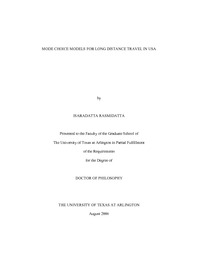| dc.description.abstract | The influences of technology and economic development on human activity are increasingly taking place on larger spatial scales. As a consequence, complementary interactions between urban regions are getting stronger, which causes urban regions to change. In order to stimulate the integration between regions and states level, policy makers need increased knowledge of the factors that influence long distance travel. From an environmental perspective, long distance trips can be very important because most of the trips are made in personal vehicles or airplanes that affect emissions and fuel consumption. Mode choice alternatives for long distance travel include: personal vehicle, air, and ground. Trip purposes (business, personal business, and pleasure) are considered in modeling. Based on the research results, a household located in an urban area plays an important role in the mode choice decision. A traveler's occupation may affect the mode choice decision between personal vehicle and public carrier; a traveler in the sales, service, or other occupational categories tends to travel by a personal vehicle rather than a public carrier. A traveler who travels over long weekends, has a household income below $20,000, lives in an urban area, has many household members on the trip, or spends not many nights on the trip prefers to make a long distance trip by personal vehicle. Considering age, as the age of traveler increases, the traveler tends to travel by the air mode; this is the same as route distance increases. In this study, variables that are exclusive to specific trip purposes between business, personal business, and pleasure include the number of vehicles in a household, traveler occupation, and household income. The prediction results show that Neural Network models (piecewise linear network floating search) outperform the percent correct for two mode choice (personal vehicle and air mode) cases and nested logit models outperform the percent correct for three mode choice (personal vehicle, air, and ground) cases. The results indicate that Neural Networks are a possible model for estimating long distance travel mode choices; however, for data mining, logistic regression provides better explanations of the variables, especially, for independence of irrelevant alternatives. | en_US |


